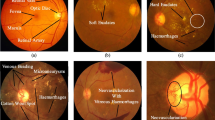Abstract
Diabetic retinopathy (DR) is an ophthalmological ailment wherein the diabetic individuals suffer from the formation of blockages, lesions, or hemorrhages predominantly in light-sensitive portion of said retina. Because of the increase in blood sugar, vascular blockage drives new vessel creation, giving rise to mesh-like patterns. As lack of timely treatment of DR results in vision loss, early diagnosis and professional assistance plays a crucial role. This can be achieved with a computer-aided diagnostic (CAD) system based on retinal fundus images. Various steps are involved in a CAD system, including as the detection, segmentation, and categorization of abnormalities in fundus images. This study is an effort to expedite the first screening of DR so as to meet the need of the increasing population of diabetic patients in the future. On publicly accessible datasets, we have trained and validated reliable classification algorithms enabling timely detection of DR. Convolutional neural networks (CNN)-based advanced deep learning models are used to fully use data-driven machine learning techniques for this purpose. We also defined the issue as the detection of DR of any grade (Grades 1–4) vs. No-DR in a binary classification (Grade 0). For training the models, we used 56,839 fundus pictures from the EyePACS dataset. On a test set from EyePACS, the models were put to the test (14,210 images). As compared to the established methods, experimental findings demonstrate superior outcomes through DenseNet with pre-trained weights. In the model’s evaluation on the EyePACS datasets, it achieved good results with an of 97.55% in binary and 78% in multiclass-classification.
Access this chapter
Tax calculation will be finalised at checkout
Purchases are for personal use only
Similar content being viewed by others
References
International Diabetes Federation. International diabetes federation diabetes atlas, 9th edn. https://www.diabetesatlas.org/en/
Jenkins, A.J., et al.: Biomarkers in diabetic retinopathy. Rev Diabet Stud. 2015 Spring-Summer 12(1–2), 159–95 (2015)
Janghorbani, M., Jones, R.B., Allison, S.P.: Incidence of and risk factors for proliferative retinopathy and its association with blindness among diabetes clinic attenders. Ophthalmic Epidemiol. 7(4), 225–241 (2000)
Bourne, R.R.A., et al.: Causes of vision loss worldwide, 1990–2010: a systematic analysis. Lancet Global Health 1(6), 339–349 (2013)
ETDRS report no 10. Grading diabetic retinopathy from stereoscopic color fundus photographs- an extension of the modified Airlie House classification. Ophthalmology 98(5), 786–806 (1991)
Scanlon, P.H., Wilkinson, C.P., Aldington, S.J., Matthews, D.R.: A Practical Manual of Diabetic Retinopathy Management. 1st edn. Wiley-Blackwell (2009)
Safi, H., Safi, S., Hafezi-Moghadam, A., Ahmadieh, H.: Early detection of diabetic retinopathy. Surv. Ophthalmol. 63(5), 601–608 (2018)
Karim, T., Riad, M.S., Kabir, R., Symptom Analysis of Diabetic Retinopathy by MicroAneurysm Detection Using NPRTOOL. In 2019 (ICREST) IEEE, pp. 606–610 (2019)
Nakayama, L.F., Ribeiro, L.Z., Gonçalves, M.B., et al.: Diabetic retinopathy classification for supervised machine learning algorithms. International J. Retina and Vitreous 8, 1 (2022)
Vujosevic, S., et al.: Screening for diabetic retinopathy: new perspectives and challenges. The Lancet Diabetes, Endocrinology 8(4), 337–347 (2020)
Esteva, A., Chou, K., Yeung, S., Naik, N., Madani, A., Mottaghi, A.et al.: Deep learning-enabled medical computer vision. NPI Digital Med. 4 (2021)
Chen, X.W.: Lin,X.: Big data deep learning: challenges and perspectives. IEEE Access 20142, 514–25 (2014)
Guo, Y., et al.: Deep learning for visual understanding: a review. Neurocomputing, 18727–48 (2016)
Bakator, M., Radosav, D.: Deep learning and medical diagnosis: a review of literature. Multimodal Technol Interact 2(3), 47 (2018)
Krizhevsky, A., Sutskever, I., Hinton, G.E.: ImageNet classification with deep convolutional neural networks. Commun ACM60(6) (2017)
Faizal, S., Rajput, C.A., Tripathi, R., et al.: Automated cataract disease detection on anterior segment eye images using adaptive thresholding and fine tuned inception-v3 model. Biomed. Signal Process. Control 82, 104550 (2023)
Sunnetci, K.M., Kaba, E., Çeliker, F.B., Alkan, A.: Comparative parotid gland segmentation by using ResNet-18 and MobileNetV2 based DeepLab v3+ architectures from magnetic resonance images. Concurrency and Computation: Practice and Experience 35(1), e74053 (2023)
Alzubaidi, L., et al.: Review of deep learning: concepts, CNN architectures, challenges, applications, future directions. Journal of Big Data 8, 53 (2021)
EyePACS Dataset, “Kaggle.” http://www.eyepacs.com
Torre, J.L., Valls, A., Puig, D.: A deep learning interpretable classifier for diabetic retinopathy disease grading. Neurocomputing 396, 465–476 (2020)
Shankar, K., Perumal, E., Vidhyavathi, R.: Deep neural network with moth search optimization algorithm-based detection and classification of diabetic retinopathy images. SN Applied Sciences 2 (2020)
Venkaiahppalaswamy, B., Reddy, P.P., Batha, S.: Hybrid deep learning approaches for the detection of diabetic retinopathy using optimized wavelet based model. Biomed. Signal Process. Control 79(2), 104146 (2023)
Babenko, B., Mitani, A., Traynis, I., et al.: Detection of signs of disease in external photographs of the eyes via deep learning. Nature Biomedical Engineering 6, 1370–1383 (2022)
Huang, X., Wang, H., She, C., Feng, J., et al.: Artificial intelligence promotes the diagnosis and screening of diabetic retinopathy. Front. Endocrinol. 13, 946915 (2022)
Selvachandran, G., Quek, S.G., Paramesran, R., et al.: Developments in the detection of diabetic retinopathy: a state-of-the-art review of computer-aided diagnosis and machine learning methods. Artificial Intelligence Review (2022). https://doi.org/10.1007/s10462-022-10185-6
Karthik, M., Dane, S.: APTOS 2019 Blindness Detection, Kaggle (2019). https://kaggle.com/competitions/aptos2019-blindness-detection
Das, S., Kharbanda, K., Raman, S.M.R., Dhas, E.: Deep learning architecture based on segmented fundus image features for classification of diabetic retinopathy. Biomed. Signal Process. Control 68, 102600 (2021)
Acknowledgment
This research study received funding from AICTE under RPS-NER scheme.
Author information
Authors and Affiliations
Corresponding author
Editor information
Editors and Affiliations
Rights and permissions
Copyright information
© 2024 The Author(s), under exclusive license to Springer Nature Switzerland AG
About this paper
Cite this paper
Biswas, A., Banik, R. (2024). Advance Detection of Diabetic Retinopathy: Deep Learning Approach. In: Dasgupta, K., Mukhopadhyay, S., Mandal, J.K., Dutta, P. (eds) Computational Intelligence in Communications and Business Analytics. CICBA 2023. Communications in Computer and Information Science, vol 1955. Springer, Cham. https://doi.org/10.1007/978-3-031-48876-4_6
Download citation
DOI: https://doi.org/10.1007/978-3-031-48876-4_6
Published:
Publisher Name: Springer, Cham
Print ISBN: 978-3-031-48875-7
Online ISBN: 978-3-031-48876-4
eBook Packages: Computer ScienceComputer Science (R0)




